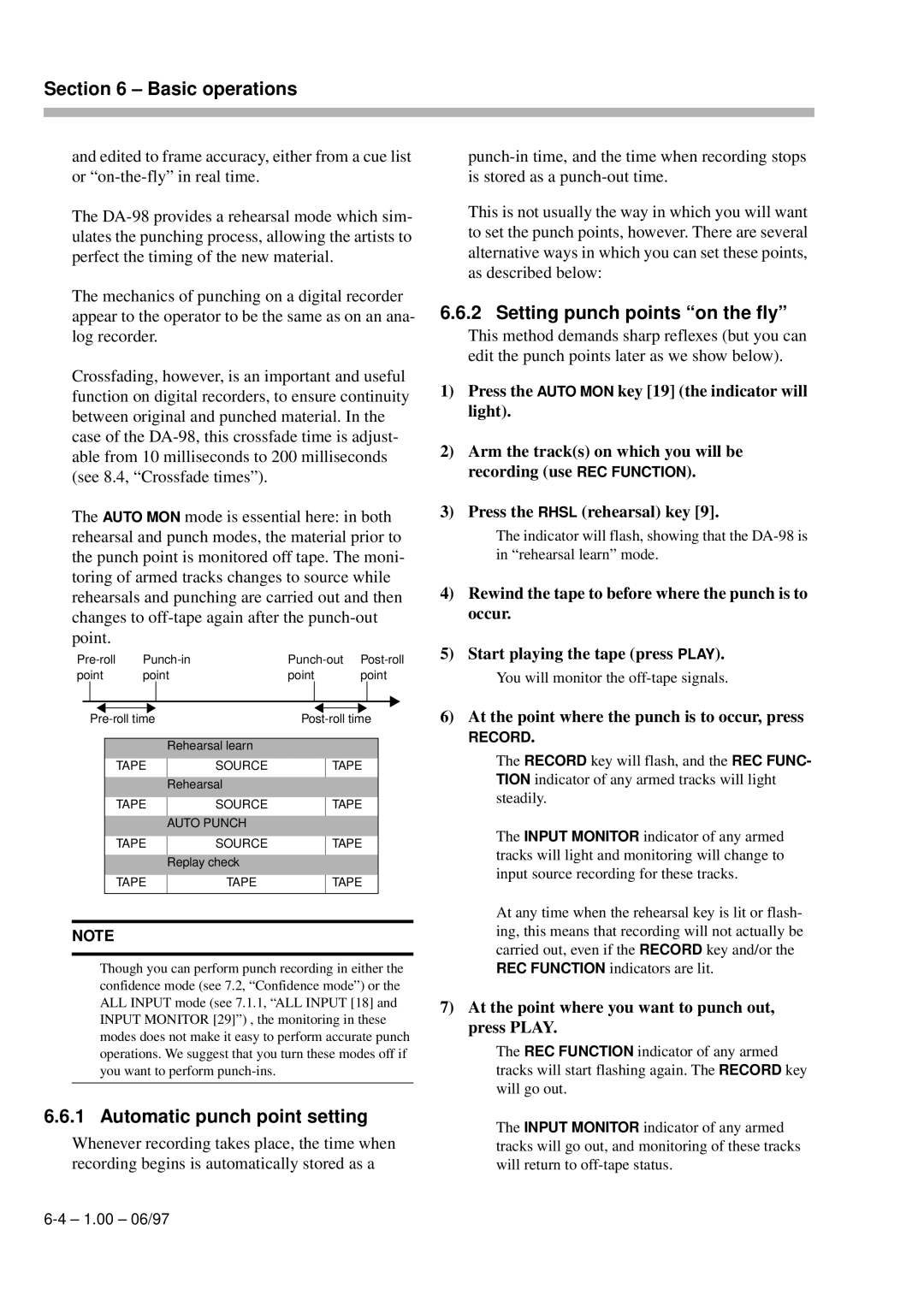DA-98
Important Safety Precautions
Important Safety Instructions
Front Panel controls
Rear Panel connectors
Table of Contents
Introduction to the DA-98
Operations related to timecode
Table of Contents Monitoring modes
Advanced operations
Synchronization with other Dtrs units
Options, specifications and reference
Table of Contents Menu and parameter reference
Example setups
Maintenance and memory setups
TOC-4 1.00 06/97
Introduction to the DA-98
Features
Unpacking
Confidence replay
Using this manual
Precautions and recommendations
Clock source in a digital studio
Condensation
Installing the DA-98
Environmental conditions
Electrical considerations
Tape brands
Recommended tapes
Available recording and playback time
Introduction to the DA-98
Front Panel controls
Digital in switch and indicator
Rhsl F 1 key and indicator
Auto Punch F 2 key Indicator
Auto Play F 4 key and indicator
Shift key and indicator
Shtl MON F 8 key and indicator
Repeat F 9 key and indicator
LOC 2 Preset key
Stop key
Front Panel controls TC REC switch and indicator
REW key
FWD key
Meter Unit MU-8824
Rear Panel connectors
Time Code in and OUT
40 RS-422
Rear Panel connectors
Audio connections
Connections
Synchronization connections
Word clock connections
1 RS-422 connector
Midi connectors in , OUT and Thru
Control connections
Indirect word sync
Connection to other Tascam units
Parallel control
Multiple Dtrs units
Connections
Menus
Menu operations
Blanking the screen display
Resetting a menu value
FunctionFunctionkey modes
Changing menu values fast
Shift key and function keys
PressLothecaFt5e0key1Pm13rien-0r5oslelc
Assigning menus to function keys
To assign a menu screen to a key
Recalling an assigned menu function
Threaded, the tape counters will show
Basic operations
Formatting a tape
Aborting the format process
Write-protecting cassettes
Recording the first tracks
Preparing to record
Recording while formatting
Replaying the first tracks
Overdubbing
Track bouncing
Punch-in and punch-out
At the point where you want to punch out, press Play
Automatic punch point setting
Setting punch points on the fly
At the point where the punch is to occur, press
Basic operations Editing the pre-roll and post-roll times
Setting punch points using the menus
Press Escape to re urn to menu group
Interrupting a rehearsal or punch recording
Rehearsing the punch-in
Recording the punch-in
To replay the punch-in, press the Play key
Exiting punch-in mode
Press the Auto MON key so that the indicator goes out
Replaying the punched material
Basic operations
Auto MON
Monitoring modes
Monitoring controls
ALL Input 18 and Input Monitor
Monitoring modes Shuttle monitoring
Confidence mode
Arming tracks in pairs
Using confidence mode
To leave confidence mode, press
Monitoring modes
Checking, editing and manually entering Memo 1 and Memo
Setting Memo 1 and Memo 2 on the fly
Setting the location pre-roll time
Advanced operations Autolocation
Pr ss Enter
Press the LOC 2/PRESET key
Moving to Memo 1 and Memo
Editing function key memories
Location and playback
Locating to a function key memory
Repeat function
To start repeat play
Crossfade times
Track delay
Press the Enter key
Press Enter
Use the UP and Down keys to adjust the crossfade time
Vari speed pitch control
Shuttle operations
Use the UP and Down keys to select between
Reference levels
Shuttle muting
LevelEnter m nu
Advanc d operations Meter ballistics
Keys to set the value for the peak signal level hold time
Meter modes
Sine oscillator
Selecting word length
Digital recording
Routing digital inputs
Changing between digital and analog inputs
Dither
REC Mute recording silence
Lecting dither settings
Setting the power-on message
Synchronization with other Dtrs units
Machine ID and master/ slave settings
Differences between Dtrs models
Ing machine offset
Setting mac ne ID
Machine offset
Offset +00
Setting machine On the fly
Cancelling machine offset
An example of setting offsets
Start playing the master DA-98
Digital dubbing
On the master machine, hold down Record and press Play
Synchronized formatting
Synchronization with other Dtrs units
Tape timecode
Operations related to timecode
ABS and SMPTE/EBU timecode
ABS time
ABS setting
Tape timecode mode
Location point settings
TcTrack setting
Checking tapeTCTrack
ABS-13 and ABS-23 settings
Timecode input
Selecting the frame rate
Timecode input and output
Pull up and pull down Fs shift
Timecode output format
Timecode output
Timecode output timing
Selecting the timecode source
Using Midi Time Code MTC
Recording timecode using the generator
Recording timecode
Frame rate
Press the TC REC switch
10.1.3, Sele ting TC or ABS timing
Select a frame rate see 10.3, Selecting
Start playing the tape
Menu see 10.2.1, TcTrack setting
Assembling timecode
External timecode sources
When recording timecode from an analog
When recording timecode from a timecode
When recording timecode from another Dtrs
When recording timecode from a digital source
Machine ID and timecode
Video resolution
Chasing to timecode
Checking external timecode
Cancelling timecode offset
Setting timecode offset
SectionOffset10 Operations related to timecode
Play the timecode master
Automatic park position setting
Park position
Absolute and relative difference
Rechasing timecode
10.7.10Bypassing timecode errors
10-14 1.00 06/97
Pro oc
Record delay
External control
Use with 9-pin external control
Fast wind speed
Cue-up tally
Still
Timecode track mapping
Track mapping
Tr k mapping and press Enter
Midi Machine Control
Bus protocol
Midi
11-6 1.00 06/97
Menu group
Menu and parameter reference Menu groups
Ference
Menu and parameter
ErrBypass
Menu and parameter Refe ence
OutTcSrcTapeTC
Section
TrkMapCueupTly
12.1.10Menu group
Stop
12.1.12Menu group F
12.1.11Menu group E
Menu item ind
ArkPsition
An all-DA-98 setup
Example setups
Post-production work
Example setups
Project studio ‘B’ room
Example setups
13-6 1.00 05/30/97
To c ean he heads and transport
Maintenance and memory setups Head and transport cleaning
Checking head time
Checking error rates
Saving user setups
User setups
Software upgrades
Resetting the memory
Checking version
Remote control RC-848
Options, specifications and reference Options for the DA-98
15.1.1 RM-98 Rack Mount Adaptor
Digital audio convertors
Control I/O connector pinout
Cables
Digital recording characteristics
Specifications
Physical specifications
Power specifications
Audio specifications Inputs and outputs
Options, specifications and reference Tape transport
15.2.8 9-pin RS-422, MIDI, synchronizer specifications
Options, specifications and reference
SYS. MAS
MMC Bit Map Array
15-7 1.00 06/97
Midi
Midi Implementation Chart
BER
Index
Index-10 1.00 06/97
06/97 1.00 Index-11
Index-12 1.00 06/97
DA-98

